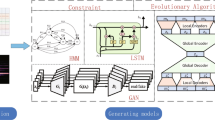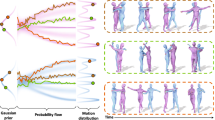Abstract
This paper presents a computer-aided tool for automatically generating Labanotation scores from motion capture data named GenLaban. GenLaban can be implemented with a low-cost equipment but an efficient method that allows users converting body motions to scores. The key components of GenLaban are the analysis of body motions, the quantization of body postures and the determination of body parts carrying the body weight. All the processes are under supervision of a Labanotation expert to ensure the notation meaning correctly as the use for the dance composition. The experiments showed that for dancers, dance instructors and choreographers, GenLaban is a potential tool for notating dance movements into Labanotation scores enabling them to be accurately interpreted. At present the system can handle a subset of Labanotation covering many of the fundamental movements. However, Labanotation is rich in symbols and new symbols are continually being introduced and will be incorporated in the GenLaban tool as time permits.






















Similar content being viewed by others
References
Bulut E, Capin T (2007) Key frame extraction from motion capture data by curve saliency. In: Proceedings of 20th Annual Conference on Computer Animation and Social Agents, Belgium
Chang CY, Lange B, Zhang M, Koenig S, Requejo P, Somboon N, Sawchuk AA, Rizzo AA (2012) Towards pervasive physical rehabilitation using microsoft kinect. In: Pervasive Computing Technologies for Healthcare (PervasiveHealth), 2012 6th International Conference on, IEEE, pp 159–162
Chen H, Miao Z, Zhu F, Zhang G, Li S (2013) Generating labanotation from motion capture data Culture and Computing (Culture Computing), 2013 International Conference on, IEEE, pp 222–223
Choensawat W, Takahashi S, Nakamura M, Choi W, Hachimura K (2010) Description and reproduction of stylized traditional dance body motion by using labanotation, vol 15(3). Transactions of the Virtual Reality Society of Japan
Coyle M, Maranan DS, Calvert T A tool for translating dance notation to animation
Fern’ndez-Baena A, Susín A, Lligadas X (2012) Biomechanical validation of upper-body and lower-body joint movements of kinect motion capture data for rehabilitation treatments In: Intelligent Networking and Collaborative Systems (INCoS), 2012 4th International Conference on, IEEE, pp 656–661
Fox I, Ryman R, Calvert T (2001) Documenting dance for the 21st century: A translation interface between labanwriter and life forms Twenty-second Biennial Conference of the International Council of Kinetography Laban. July–2 August, vol 26, pp 193–205
Guest AH (2013) Labanotation: the system of analyzing and recording movement. Routledge
Hachimura K (2006) Digital archiving of dancing. Review of the National Center for Digitization (Online Journal) 8:51–66
Hachimura K (2009) Digital archiving of dance by using motion-capture technology. New Directions in Digital Humanities for Japanese Arts and Cultures. In: Kawashima A, et al. (eds), pp 167–181
Hachimura K, Nakamura M (2001) Method of generating coded description of human body motion from motion-captured data In: Robot and Human Interactive Communication, 2001. Proceedings. 10th IEEE International Workshop on, pp 122–127
Hutchinson Guest A (1977) Labanotation. New York, Routledge Chapman & Hall
Kannan R, Andres F, Guetl C (2010) Danvideo: an mpeg-7 authoring and retrieval system for dance videos. Multimed Tools Appl 46(2-3):545–572
Kojima K, Hachimura K, Nakamura M (2002) Labaneditor: Graphical editor for dance notation In: Robot and Human Interactive Communication, 2002. Proceedings. 11th IEEE International Workshop on, pp. IEEE, pp 59–64
Lim I, Thalmann D (2001) Key-posture extraction out of human motion data In:Engineering in Medicine and Biology Society, 2001. Proceedings of the 23rd Annual International Conference of the IEEE, vol 2, IEEE, pp 1167–1169
Meredith M, Maddock S (2001) Motion capture file formats explained. Department of Computer Science. University of Sheffield 211
Microsoft: Tracking users with kinect skeletal tracking. http://msdn.microsoft.com/en-us/library/jj131025.aspx. Accessed: 2013-10-30
MoCap C (2003) The data used in this project was obtained from mocap. cs. cmu. edu. the database was created with funding from nsf eia-0196217
Soga A, Umino B, Yasuda T, Yokoi S (2007) Automatic composition and simulation system for ballet sequences. Vis Comput 23(5):309–316
Wilke L, Calvert T, Ryman R, Fox I (2005) From dance notation to human animation: The labandancer project. Comput Animat Virtual Worlds 16(3-4):201–211
Xiao J, Zhuang Y, Wu F, Guo T, Liang Z (2010) A group of novel approaches and a toolkit for motion capture data reusing. Multimed Tools Appl 47(3):379–408
Acknowledgments
This work is supported in part by the Institute of Research Promotion and Innovation Development at Bangkok University and the Grant-in-Aid for Scientific Research (B) No. 22300039 from MEXT Japan.
Author information
Authors and Affiliations
Corresponding author
Rights and permissions
About this article
Cite this article
Choensawat, W., Nakamura, M. & Hachimura, K. GenLaban: A tool for generating Labanotation from motion capture data. Multimed Tools Appl 74, 10823–10846 (2015). https://doi.org/10.1007/s11042-014-2209-6
Received:
Revised:
Accepted:
Published:
Issue Date:
DOI: https://doi.org/10.1007/s11042-014-2209-6




